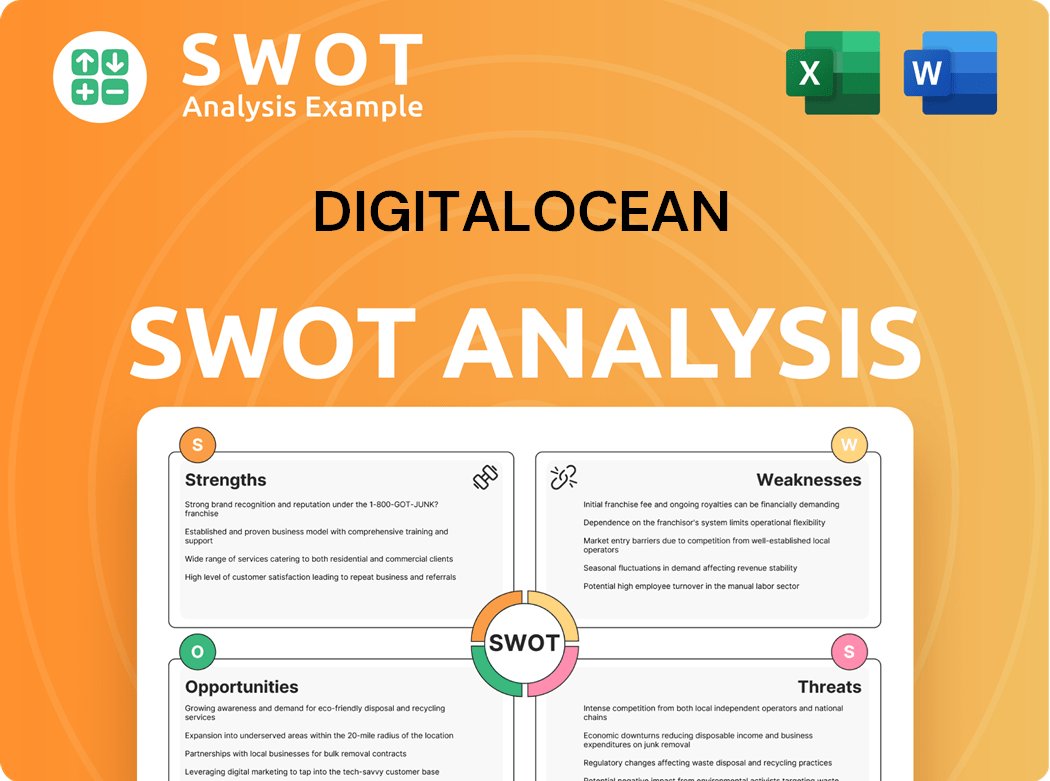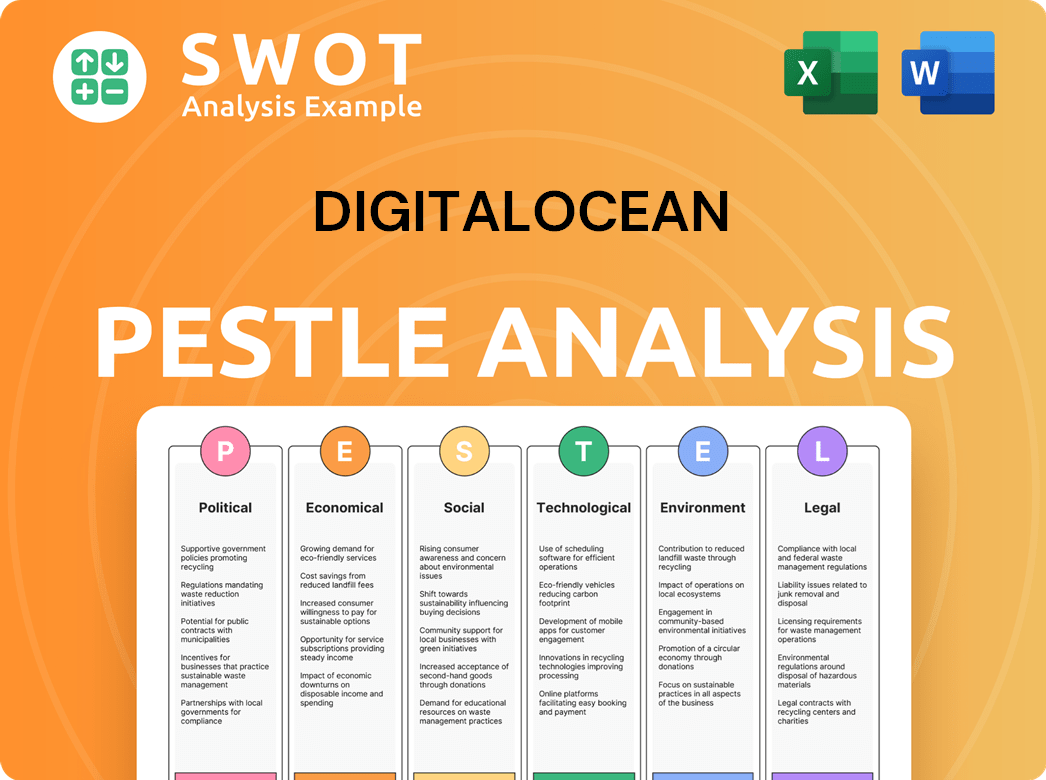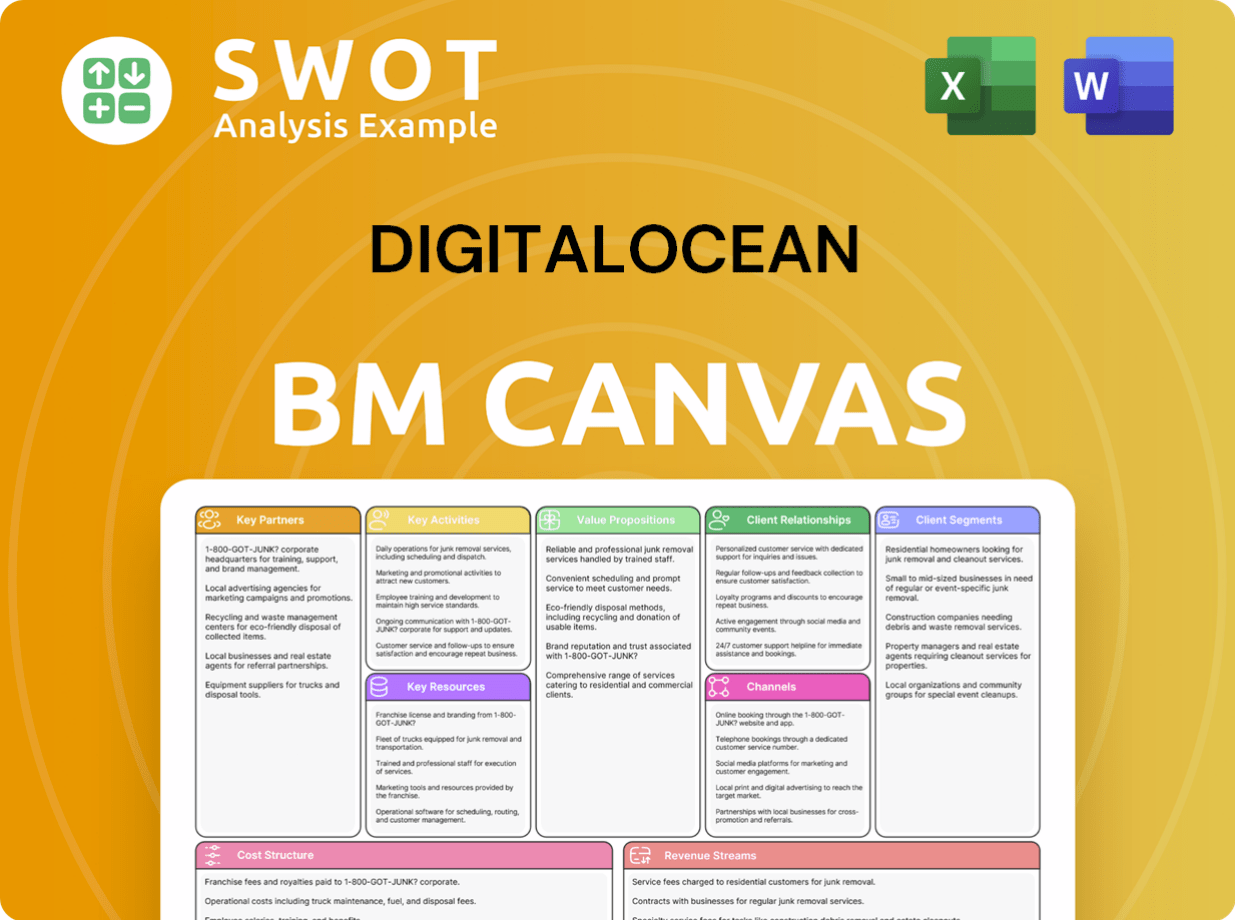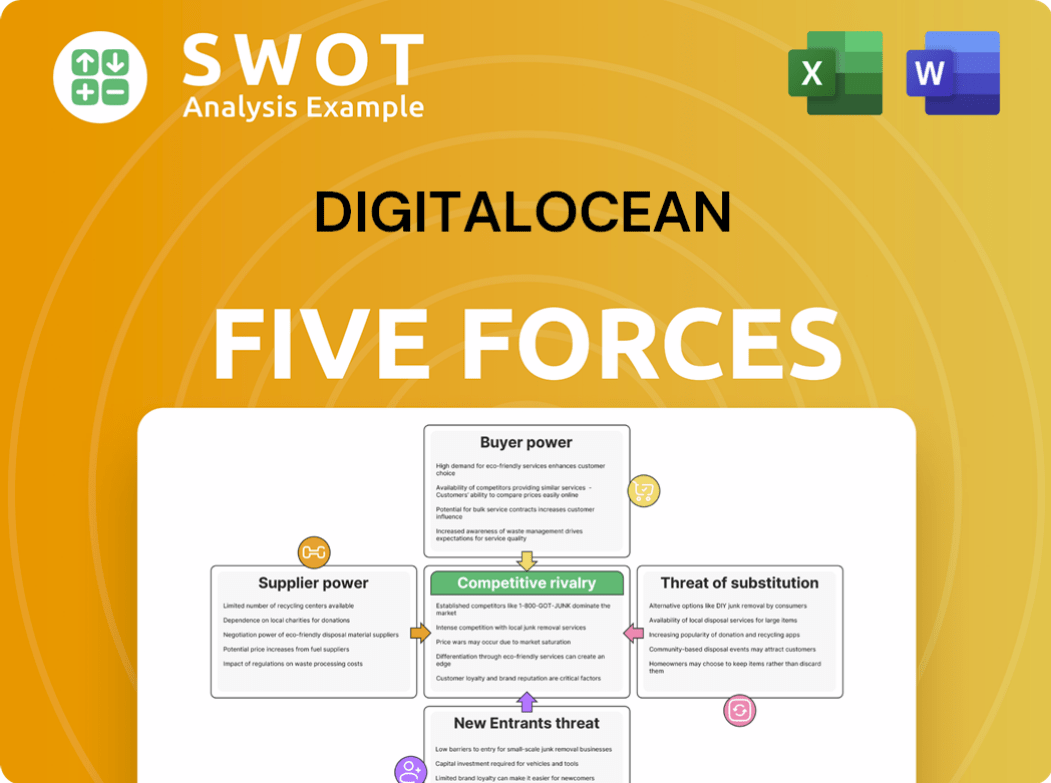DigitalOcean Bundle
How Does DigitalOcean Stack Up in the Cloud Computing Arena?
The cloud computing industry is a battleground of innovation and fierce competition, constantly reshaping how businesses operate. DigitalOcean has emerged as a key player, specifically targeting developers and SMBs. Understanding the DigitalOcean SWOT Analysis is crucial for navigating this dynamic market. This analysis will help you to understand the DigitalOcean competitive landscape.

This deep dive into the DigitalOcean competitive landscape will dissect its market position and key rivals. We'll explore the company's strengths, weaknesses, and the competitive advantages that set it apart. Furthermore, we'll examine the industry trends and challenges, providing a comprehensive DigitalOcean market analysis to inform your investment and strategic decisions. We will also look at DigitalOcean competitors and DigitalOcean alternatives.
Where Does DigitalOcean’ Stand in the Current Market?
DigitalOcean's core operations revolve around providing cloud computing services tailored for developers, startups, and small to medium-sized businesses (SMBs). The company's value proposition centers on simplicity, affordability, and a developer-friendly experience, distinguishing it from larger, more complex cloud providers.
Its primary offerings include virtual machines (Droplets), managed databases, managed Kubernetes, object storage (Spaces), and networking services. DigitalOcean strategically positions itself to meet the needs of users who prioritize ease of use and cost-effectiveness, making it a strong contender in the DigitalOcean's marketing strategy.
DigitalOcean's competitive landscape is shaped by its focus on a specific segment within the broader cloud computing market. The company's market position is characterized by its emphasis on ease of use, developer-centric tools, and predictable pricing, which attracts a particular customer base.
While specific market share figures for DigitalOcean within its niche can vary, it consistently ranks as a leading provider. The company has demonstrated consistent growth, with revenue of $183 million in Q4 2024, representing a 12% year-over-year increase. Full-year 2024 revenue reached $710 million.
DigitalOcean primarily targets developers, startups, and SMBs. These customers value ease of use, straightforward pricing, and a strong developer ecosystem. The company's services are designed to be accessible and efficient, catering to the needs of these specific user groups.
DigitalOcean has a global presence with data centers strategically located across North America, Europe, Asia, and Australia. This wide geographic distribution enables the company to serve a diverse international customer base, ensuring low latency and reliable service.
DigitalOcean's financial health is a key indicator of its market position. The consistent revenue growth and profitability demonstrate its strong standing within its target segments. The company’s performance reflects its ability to attract and retain customers in the competitive cloud market.
DigitalOcean distinguishes itself through its focus on simplicity, developer-centric tools, and transparent pricing. This strategic positioning allows it to capture a significant share of the developer and SMB market.
- Competitive pricing compared to hyperscalers.
- User-friendly interface and developer-friendly tools.
- Strong focus on customer support and community.
- Strategic data center locations for global reach.
DigitalOcean SWOT Analysis
- Complete SWOT Breakdown
- Fully Customizable
- Editable in Excel & Word
- Professional Formatting
- Investor-Ready Format

Who Are the Main Competitors Challenging DigitalOcean?
The DigitalOcean competitive landscape is shaped by a diverse range of cloud computing providers. This analysis examines the key players vying for market share in the Infrastructure as a Service (IaaS) sector, focusing on direct and indirect competitors.
Understanding the competitive dynamics is crucial for assessing DigitalOcean's position and potential for growth. This involves evaluating its strengths and weaknesses relative to its rivals, as well as analyzing market trends and customer preferences. The following sections provide a detailed overview of DigitalOcean's key competitors and their strategies.
DigitalOcean's direct competitors primarily target developers and small to medium-sized businesses (SMBs) with simplified cloud offerings. These competitors often emphasize ease of use, competitive pricing, and developer-friendly features. These include Linode (now part of Akamai), Vultr, and Hetzner.
Linode, now part of Akamai, offers virtual private server (VPS) services similar to DigitalOcean, with a strong focus on developer-friendliness and competitive pricing. Akamai's acquisition of Linode in 2022 expanded its cloud computing capabilities, potentially intensifying competition in the IaaS market. Linode's global presence and focus on ease of use make it a direct alternative for many users.
Vultr provides a range of cloud computing services, emphasizing performance and global reach. It often competes on price and specialized instances, attracting users looking for cost-effective solutions. Vultr's focus on global data center locations and various instance types makes it a strong contender in the DigitalOcean alternatives space.
Hetzner, based in Germany, is known for its highly competitive pricing for dedicated servers and cloud instances. It attracts cost-conscious developers and businesses. Hetzner's focus on providing affordable infrastructure solutions positions it as a key player in the value-driven segment of the market.
DigitalOcean also indirectly competes with the hyperscale cloud providers: Amazon Web Services (AWS), Microsoft Azure, and Google Cloud Platform (GCP). While these giants primarily target larger enterprises, their entry-level offerings can attract startups and individual developers. These providers offer a broader range of services but can be more complex to navigate.
AWS, a dominant player in the cloud market, offers a comprehensive suite of services. AWS Lightsail is a direct competitor to DigitalOcean's Droplets, offering simplified virtual servers. AWS's vast ecosystem and extensive service offerings make it a significant competitor, especially for businesses planning to scale.
Azure provides a wide range of cloud services, including streamlined platforms for deploying applications. Azure's App Service can divert customers who might otherwise choose DigitalOcean. Azure's integration with Microsoft's ecosystem and enterprise focus gives it a competitive edge in certain segments.
GCP offers various cloud services, including App Engine, which provides streamlined platforms for deploying applications. GCP's focus on data analytics and machine learning, along with its competitive pricing, makes it a strong contender, particularly for startups and developers. GCP's innovative technologies and developer-friendly tools attract a significant user base.
The competitive landscape is further influenced by emerging players offering niche services or specialized platforms. The potential for mergers and acquisitions could also reshape market dynamics. Understanding these factors is crucial for DigitalOcean to maintain its market position and continue its growth. In 2024, the cloud infrastructure market is expected to continue its expansion, with a projected market size of over $600 billion, according to Gartner. This growth will likely intensify competition among cloud providers, making strategic positioning and innovation essential for success.
Several factors influence the competitive landscape for DigitalOcean and other cloud computing providers. These include pricing, ease of use, performance, global reach, and the availability of specialized services. Understanding these factors is crucial for both providers and customers.
- Pricing: Competitive pricing is a significant factor, with providers like Hetzner often attracting cost-conscious customers. DigitalOcean's pricing plans are designed to be transparent and competitive.
- Ease of Use: Developer-friendliness and ease of use are crucial, especially for SMBs and individual developers. DigitalOcean, Linode, and others prioritize user-friendly interfaces and simplified management tools.
- Performance: The performance of cloud instances and network infrastructure is critical. Vultr and others emphasize high-performance offerings to attract users with demanding workloads.
- Global Reach: The availability of data centers in various geographic locations is essential for serving a global customer base. DigitalOcean, AWS, and others have extensive data center networks.
- Specialized Services: The availability of specialized services, such as managed databases, object storage, and Kubernetes, can differentiate providers. AWS and GCP offer a wide range of specialized services, while DigitalOcean continues to expand its offerings.
DigitalOcean PESTLE Analysis
- Covers All 6 PESTLE Categories
- No Research Needed – Save Hours of Work
- Built by Experts, Trusted by Consultants
- Instant Download, Ready to Use
- 100% Editable, Fully Customizable

What Gives DigitalOcean a Competitive Edge Over Its Rivals?
Understanding the DigitalOcean competitive landscape requires a deep dive into its core strengths. The company has carved a niche by prioritizing simplicity and a developer-centric approach. This focus allows it to stand out in a market dominated by larger players. The company's commitment to a clear and predictable pricing model is another key differentiator, especially appealing to startups and small to medium-sized businesses (SMBs).
The company's competitive edge is further solidified by its proprietary technologies and operational efficiencies. DigitalOcean has optimized its infrastructure to meet the specific needs of its target customers, focusing on performance and reliability for common developer workloads. Its strong brand equity, built through consistent service and community engagement, also plays a crucial role. The company's extensive documentation and active community forums provide invaluable support, fostering a strong sense of partnership with its users.
This article explores the DigitalOcean competitors and the strategies that have enabled it to thrive in the cloud computing market. The company's ability to maintain its developer-focused culture and community, even as larger competitors attempt to simplify their offerings, is crucial. The company’s journey and future prospects are closely tied to its ability to adapt and innovate in a rapidly evolving industry. For more information, explore the Growth Strategy of DigitalOcean.
DigitalOcean's platform is designed for ease of use, allowing developers to quickly deploy and manage applications. This 'developer-first' approach reduces the learning curve and operational overhead. This focus on simplicity is a key factor in attracting and retaining its target audience.
DigitalOcean offers a predictable and transparent pricing model, which is attractive to startups and SMBs. Its clear cost structure contrasts with the often complex and variable pricing of larger cloud providers. This transparency helps in budgeting and cost management.
The platform is built with developers in mind, offering tools and features that streamline the development process. This focus on the developer experience is a significant differentiator. The company's tools and services are tailored to meet the needs of developers.
DigitalOcean has cultivated a strong community through extensive documentation, tutorials, and active forums. This support system fosters a sense of partnership with its users. The community provides invaluable resources and helps users solve problems.
DigitalOcean's competitive advantages are rooted in its focus on simplicity, developer-centric design, and community engagement. These factors have enabled the company to capture a significant portion of the cloud computing market. The company’s ability to maintain its developer-focused culture is a key differentiator.
- Ease of Use: DigitalOcean's platform is known for its simplicity, allowing developers to quickly deploy and manage applications.
- Predictable Pricing: The transparent pricing model offers a clear cost structure, appealing to startups and SMBs.
- Developer-First Approach: The platform is designed with developers in mind, reducing the learning curve and operational overhead.
- Strong Community: Extensive documentation, tutorials, and active community forums provide invaluable support.
DigitalOcean Business Model Canvas
- Complete 9-Block Business Model Canvas
- Effortlessly Communicate Your Business Strategy
- Investor-Ready BMC Format
- 100% Editable and Customizable
- Clear and Structured Layout

What Industry Trends Are Reshaping DigitalOcean’s Competitive Landscape?
Analyzing the DigitalOcean competitive landscape requires understanding the evolving cloud computing industry. The market is dynamic, with established players and emerging challengers vying for market share. Understanding DigitalOcean competitors and the broader DigitalOcean market analysis is crucial for assessing its strategic position and future prospects.
The cloud computing market is experiencing significant growth. The global cloud computing market was valued at $545.8 billion in 2023 and is projected to reach $1.6 trillion by 2030, growing at a CAGR of 16.8% from 2023 to 2030, according to Grand View Research. This growth presents both opportunities and challenges for cloud computing providers like DigitalOcean. Specifically, the Infrastructure as a Service (IaaS) segment, where DigitalOcean primarily operates, is a key area of expansion.
Several trends are shaping the cloud computing landscape. The increasing adoption of AI and ML is driving demand for specialized cloud services. Data privacy regulations and the need for data sovereignty are influencing infrastructure decisions. Furthermore, there's a growing preference for specialized and vertical-specific cloud solutions.
Key challenges include competition from hyperscale providers, aggressive pricing strategies, and the emergence of new technologies. The expansion of hyperscalers into the SMB space, which DigitalOcean targets, poses a significant threat. Adapting to evolving customer demands and regulatory changes is also crucial.
Significant opportunities exist in emerging markets and through product innovation. Focusing on managed services and strategic partnerships can expand market reach. The continued growth of the SMB and developer segments, which DigitalOcean serves, offers a strong foundation for expansion.
DigitalOcean needs to invest in product development, strategic partnerships, and understanding its target market. Focusing on ease of use and competitive pricing remains critical. Adapting to changing customer needs and technological advancements is essential for long-term success.
DigitalOcean's growth is influenced by several factors. The company's focus on simplicity and ease of use appeals to developers and SMBs. Strategic partnerships and expansion into new geographic markets are also important. Moreover, the demand for cloud services continues to rise, creating a favorable environment.
- Target Market: DigitalOcean's emphasis on developers and SMBs is a key differentiator.
- Product Innovation: Continuous improvement in features and services is vital.
- Strategic Partnerships: Collaborations with software vendors and educational institutions can expand reach.
- Market Expansion: Targeting emerging markets offers significant growth potential.
DigitalOcean Porter's Five Forces Analysis
- Covers All 5 Competitive Forces in Detail
- Structured for Consultants, Students, and Founders
- 100% Editable in Microsoft Word & Excel
- Instant Digital Download – Use Immediately
- Compatible with Mac & PC – Fully Unlocked

Related Blogs
- What are Mission Vision & Core Values of DigitalOcean Company?
- What is Growth Strategy and Future Prospects of DigitalOcean Company?
- How Does DigitalOcean Company Work?
- What is Sales and Marketing Strategy of DigitalOcean Company?
- What is Brief History of DigitalOcean Company?
- Who Owns DigitalOcean Company?
- What is Customer Demographics and Target Market of DigitalOcean Company?
Disclaimer
All information, articles, and product details provided on this website are for general informational and educational purposes only. We do not claim any ownership over, nor do we intend to infringe upon, any trademarks, copyrights, logos, brand names, or other intellectual property mentioned or depicted on this site. Such intellectual property remains the property of its respective owners, and any references here are made solely for identification or informational purposes, without implying any affiliation, endorsement, or partnership.
We make no representations or warranties, express or implied, regarding the accuracy, completeness, or suitability of any content or products presented. Nothing on this website should be construed as legal, tax, investment, financial, medical, or other professional advice. In addition, no part of this site—including articles or product references—constitutes a solicitation, recommendation, endorsement, advertisement, or offer to buy or sell any securities, franchises, or other financial instruments, particularly in jurisdictions where such activity would be unlawful.
All content is of a general nature and may not address the specific circumstances of any individual or entity. It is not a substitute for professional advice or services. Any actions you take based on the information provided here are strictly at your own risk. You accept full responsibility for any decisions or outcomes arising from your use of this website and agree to release us from any liability in connection with your use of, or reliance upon, the content or products found herein.